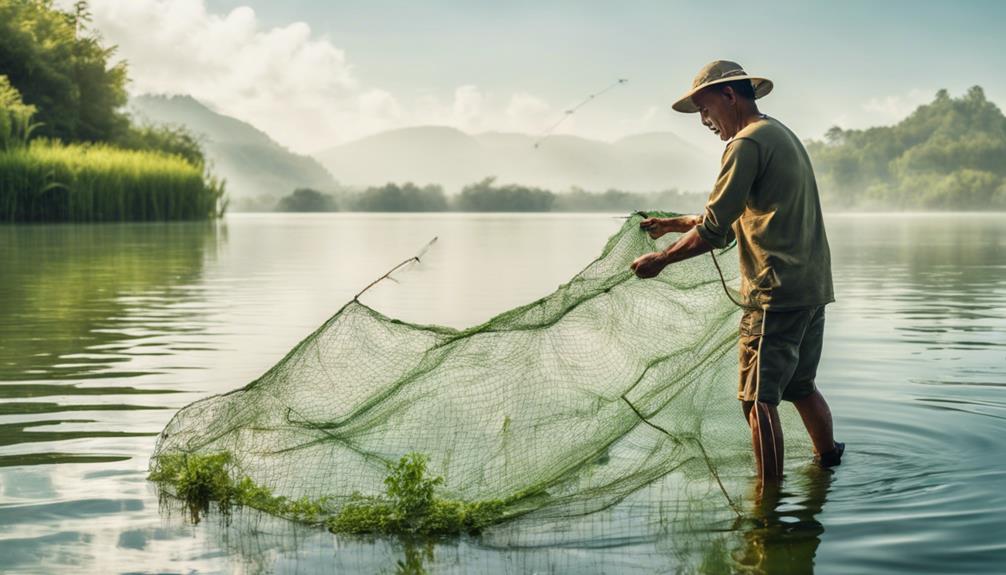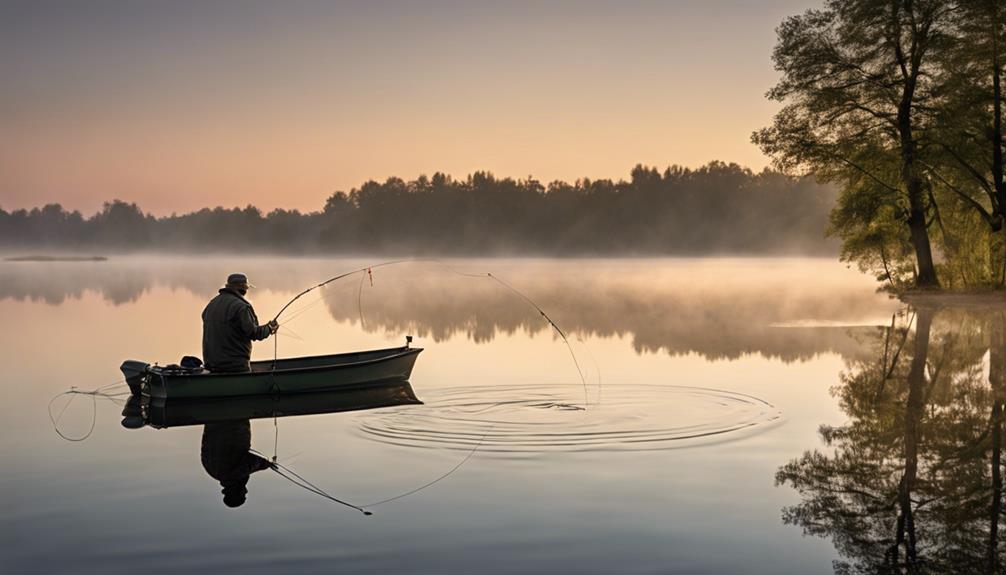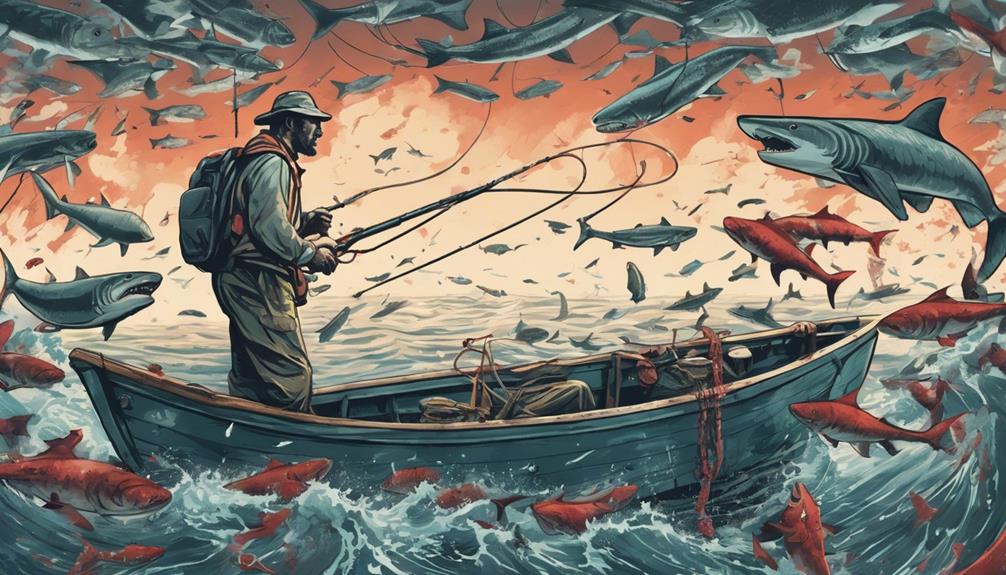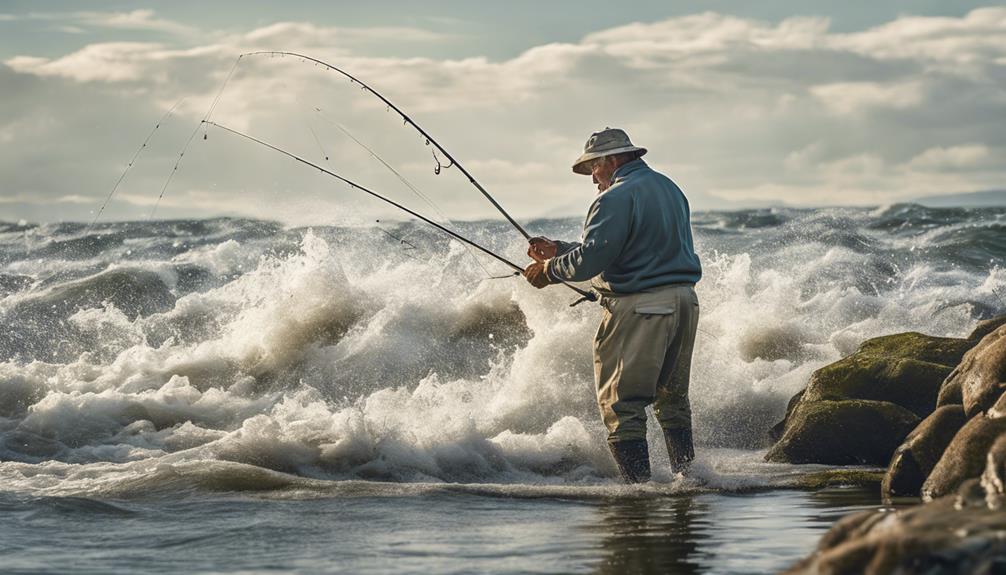Imagine a fishing community that successfully implemented habitat restoration initiatives, leading to increased fish populations and healthier ecosystems. The key to sustainable fishing lies in a combination of innovative techniques and mindful practices.
From selective fishing gear to community-based fisheries management, each strategy plays a vital role in preserving marine resources for future generations.
But what are the other seven eco-friendly techniques that can revolutionize the fishing industry?
Selective Fishing Gear
To reduce bycatch and minimize environmental impact, choose fishing gear that targets specific species. By opting for eco-friendly gear and implementing sustainable practices, you can contribute to the preservation of marine ecosystems while still engaging in productive fishing activities.
When selecting fishing gear, prioritize eco-friendly options such as circle hooks, barrier nets, or traps that have been proven to reduce bycatch significantly. These gears are designed to target specific species, allowing non-targeted marine life to escape unharmed. By avoiding indiscriminate methods like bottom trawling or gillnets, you can help maintain a balanced marine environment.
Incorporating sustainable practices into your fishing routine is crucial for long-term environmental conservation. Support initiatives that promote gear recycling or participate in programs that encourage responsible fishing practices. By being mindful of the impact your gear choices have on the environment, you can actively contribute to the sustainability of fish populations and marine habitats.
Proper Waste Disposal
Choose the responsible disposal of waste from your fishing activities to minimize environmental harm and safeguard marine ecosystems. Proper waste disposal is crucial for sustainable fishing practices. One way to achieve this is by using biodegradable materials whenever possible. Opt for fishing gear made from natural materials that break down over time, reducing the amount of waste that ends up in the oceans. Additionally, consider participating in recycling programs specifically designed for fishing waste.
When disposing of any non-biodegradable waste, such as old fishing lines or nets, make sure to properly recycle them. Many fishing lines are made of materials that can be recycled into new products, preventing them from polluting the oceans or harming marine life. By taking the extra step to recycle these items, you contribute to the conservation of marine ecosystems.
Participating in recycling programs not only helps keep the oceans clean but also encourages others in the fishing community to follow suit. By setting an example and promoting responsible waste disposal practices, you can make a significant impact on the environment. Remember, every small action counts towards preserving the delicate balance of marine ecosystems.
Responsible Aquaculture Practices
Consider implementing sustainable aquaculture practices to ensure the health of aquatic environments and the long-term viability of fish populations. When engaging in aquaculture, opt for ocean-friendly feed sourcing to reduce the impact on marine ecosystems. By choosing feeds that are sustainably sourced and don't deplete wild fish populations, you can help maintain the delicate balance of marine life.
Water quality monitoring is another crucial aspect of responsible aquaculture practices. Regularly assess and maintain water quality in aquaculture systems to prevent pollution and ensure the well-being of the fish. Monitoring parameters such as oxygen levels, pH, and nutrient concentrations can help you intervene promptly if any issues arise, safeguarding both the fish and the surrounding aquatic environment.
Incorporating ocean-friendly feed sourcing and implementing rigorous water quality monitoring are essential steps towards sustainable aquaculture. By being mindful of the inputs into aquaculture systems and actively monitoring their impact on the environment, you can contribute to the preservation of marine ecosystems and the longevity of fish populations. Embracing these practices not only benefits the health of aquatic environments but also supports the goal of sustainable fishing for generations to come.
Habitat Restoration Initiatives
Implementing habitat restoration initiatives plays a vital role in preserving and enhancing the natural ecosystems that support fish populations. By focusing on wetland preservation and species reintroduction, these initiatives aim to create a healthier environment for fish to thrive.
Here are four key reasons why habitat restoration is crucial for sustainable fishing:
- Enhanced Biodiversity: Restoring habitats such as wetlands can help support a diverse range of species, including those that are essential for maintaining a balanced ecosystem. By reintroducing native species, we can promote biodiversity and ensure the survival of various fish populations.
- Improved Water Quality: Wetland preservation plays a significant role in maintaining water quality by acting as natural filters. These habitats can help reduce pollutants and sediment from reaching water bodies, creating a healthier environment for fish to live in.
- Protection of Fish Spawning Grounds: Habitat restoration initiatives help protect and restore critical spawning grounds for fish. By ensuring that these areas are healthy and intact, we can support the reproductive cycles of fish species and prevent their decline.
- Long-Term Sustainability: Investing in habitat restoration now can lead to long-term benefits for both fish populations and the environment. By creating resilient ecosystems through initiatives like species reintroduction, we can ensure sustainable fishing practices for future generations.
Seasonal Fishing Strategies
An effective approach to optimizing your fishing endeavors throughout the year involves strategically adapting to seasonal changes in fish behavior and habitat preferences. Understanding the seasonal variations in catch limits and migration patterns is crucial for sustainable fishing practices.
During different times of the year, fish species exhibit varying behaviors and preferences. For example, in the spring, many fish species are actively feeding and preparing for spawning, making it an ideal time for fishing. Understanding the catch limits set for each species during their peak seasons is essential to prevent overfishing and ensure the long-term health of fish populations.
Migration patterns also play a significant role in seasonal fishing strategies. Some fish species migrate to specific areas during certain times of the year, such as moving to shallower waters in the summer or deeper waters in the winter. By knowing these patterns, you can adjust your fishing techniques and locations to target fish more effectively while minimizing bycatch.
To make the most of seasonal fishing opportunities, consider keeping a fishing calendar that outlines the best times to target specific species in your region. By staying informed about catch limits, migration patterns, and seasonal variations, you can enhance your fishing success while promoting sustainable practices for the future.
Bycatch Reduction Methods
To reduce bycatch in your fishing practices, prioritize using selective gear and techniques that target specific fish species. By focusing on minimizing bycatch, you can help protect vulnerable marine species and promote sustainable fishing practices. Here are some effective methods to reduce bycatch:
- Use Turtle Excluder Devices (TEDs): Incorporating TEDs in your fishing gear can help prevent sea turtles from getting caught unintentionally. These devices allow turtles to escape while retaining the target catch.
- Implement Seabird Deterrents: Seabirds are often unintentional victims of bycatch. Using deterrents such as bird-scaring lines or underwater bait setting can help reduce interactions with seabirds.
- Selective Fishing Techniques: Opt for gear and methods that target specific fish species, reducing the chances of catching non-target species. This includes using hooks of appropriate sizes and avoiding fishing in areas with high bycatch rates.
- Regular Gear Maintenance: Keep your fishing gear well-maintained to ensure optimal performance. Damaged gear or improperly functioning equipment can increase the likelihood of bycatch.
Community-Based Fisheries Management
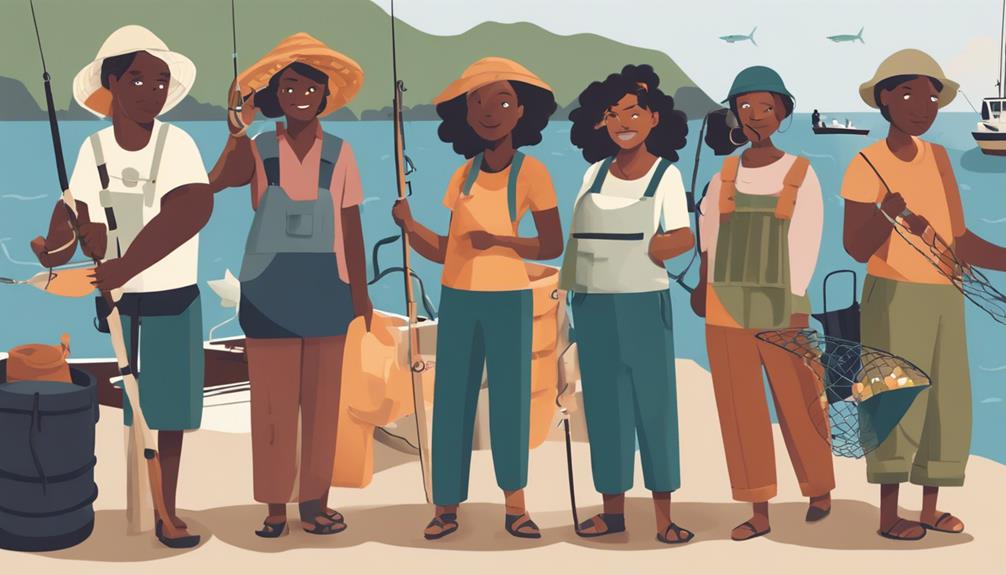
Community-based fisheries management involves active participation and collaboration among local fishing communities to promote sustainable fishing practices and ensure the long-term health of marine ecosystems. By engaging stakeholders in decision-making processes and resource allocation, this approach empowers local communities to take ownership of their fisheries and work towards long-term sustainability.
One key aspect of community-based fisheries management is the emphasis on data collection. Local fishers play a crucial role in gathering information about fish stocks, catch sizes, and other relevant data. This data is then used to inform decision-making processes, helping communities develop effective management strategies based on scientific evidence.
In this framework, decision-making is a collaborative effort. Local fishers, along with scientists and policymakers, work together to create management plans that balance ecological conservation with the socio-economic needs of the community. By involving all stakeholders in the decision-making process, community-based fisheries management ensures that the voices of those directly impacted by fishing activities are heard and considered.
Marine Protected Areas
Marine Protected Areas play a crucial role in safeguarding marine biodiversity and habitats. These areas are designated to protect and conserve marine ecosystems, providing a safe haven for various species to thrive.
Here are four key aspects to consider when discussing Marine Protected Areas:
- Ecotourism Benefits: Marine Protected Areas not only serve as conservation zones but also attract tourists interested in experiencing the beauty of marine life. Ecotourism can bring economic benefits to local communities while raising awareness about the importance of preserving these areas.
- Conservation: By limiting human activities such as fishing and mining, Marine Protected Areas help conserve fragile marine ecosystems. This conservation effort is essential in preserving biodiversity and ensuring the long-term sustainability of marine resources.
- Enforcement Challenges: Despite their importance, Marine Protected Areas often face challenges in enforcement due to illegal fishing activities and lack of resources. Strengthening enforcement measures is crucial to maintain the effectiveness of these protected zones.
- Effectiveness: Studies have shown that well-managed Marine Protected Areas can lead to ecosystem recovery and increased biodiversity. Monitoring and evaluating the effectiveness of these areas are vital to adapt conservation strategies and ensure their long-term success.
Frequently Asked Questions
How Can Consumers Ensure That the Seafood They Purchase Is Sustainably Sourced?
To ensure the seafood you buy is sustainably sourced, stay informed about where it comes from. Make ethical choices by supporting transparent companies that follow traceability standards.
Look for labels like MSC or ASC that certify sustainable practices. Ask questions at the store or restaurant about the origins of the seafood.
Are There Any Certifications or Labels That Consumers Can Look for to Identify Eco-Friendly Seafood Products?
When looking for eco-friendly seafood products, you should check for certification programs and labeling standards. These indicators can help you identify sustainably sourced options.
Look for labels like MSC (Marine Stewardship Council) or ASC (Aquaculture Stewardship Council) on the packaging. These certifications ensure that the seafood was harvested or farmed using environmentally responsible practices.
What Role Do Government Regulations Play in Promoting Sustainable Fishing Practices?
Government oversight is crucial in promoting sustainable fishing practices. Regulations set by authorities ensure that fishing activities are conducted in an environmentally responsible manner.
How Can Individuals Get Involved in Supporting Sustainable Fishing Efforts in Their Local Communities?
To support sustainable fishing in your community, you can get involved by participating in community outreach programs and volunteering for local initiatives.
Join educational workshops and awareness campaigns to learn more about sustainable fishing practices and spread the word to others.
What Are Some Potential Consequences of Not Implementing Eco-Friendly Techniques in the Fishing Industry?
Neglecting eco-friendly techniques in fishing leads to negative impacts like overfishing and habitat destruction. Environmental degradation occurs when unsustainable practices disrupt marine ecosystems, causing declines in fish populations and harming other species.
Without proper conservation measures, the fishing industry risks depleting resources and damaging marine environments. By implementing sustainable methods, you can help safeguard the oceans for future generations and promote healthier ecosystems.
Conclusion
In conclusion, by incorporating these eco-friendly techniques into your fishing practices, you can help protect marine ecosystems and ensure sustainable fishing for generations to come.
Remember to use selective gear, dispose of waste properly, and support responsible aquaculture.
Take action to reduce bycatch, restore habitats, and promote community-based fisheries management.
Together, we can make a positive impact on the environment and preserve our oceans for future enjoyment.
